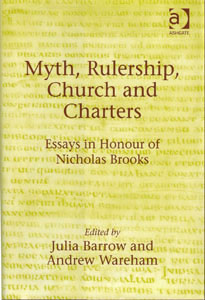
De Re Militari | Book Reviews
Julia Barrow and Andrew Wareham (eds.),
Myth, Rulership, Church and Charters: Essays in Honour of Nicholas Brooks
(Aldershot: Ashgate, 2008). 286pp. $99.95. ISBN 9780754651208.

Nicholas Brooks’s contributions to the field of Anglo-Saxon history are admirably elucidated and expanded upon in this festschrift edited by Julia Barrow and Andrew Wareham. In sixteen articles, largely drawn from among the leading Anglo-Saxonists working today, the book examines the contributions that Professor Brooks made to Anglo-Saxon history, and expands his work into new and exciting areas.
The first two chapters introduce Professor Brooks the scholar and his significant contributions to the field. Both Julia Barrow and Christopher Dyer demonstrated Brooks’s dedication to excellence in a variety of fields, and Barrow specifically illuminated Brooks’s constant encouragement to consider Anglo-Saxon history in a larger European context. His devotion to examining Anglo-Saxon England in a comparative context is reflected in James Campbell’s interesting article on Eben Robertson, “A Nearly, but Wrongly, Forgotten Historian of the Dark Ages” (Chapter 4). In detailing the life of this largely forgotten historian, Campbell demonstrates how Robertson had used a similarly comparative approach to Brooks, how his innovative approach was later expanded upon and synthesized by Professor Brooks. Janet Nelson’s article on the second Anglo-Saxon Ordo (Chapter 10) furthers this theme of comparative history.
Professor Brooks made important scholarly contributions to our understanding of the links between myths and identity. As he himself wrote in 2000, “Myth has a central role in defining core beliefs about national and ethnic origins.”[1] His interest in this area receives admirable treatment in this book in Barbara Yorke’s article on Anglo-Saxon Origin Legends (Chapter 3). Yorke writes effectively about the connection between myth and identity, and specifically of the importance of material culture in reconstructing notions of identity and political allegiance.
Articles by Simon Keynes Julia Barrow, Susan Kelly, and Margaret Gelling show the importance and value of using charters as evidence of the Anglo-Saxon past, as well as the current state of research into charter study. Professor Keynes places Professor Brooks squarely in the center of the historiography of Anglo-Saxon charter studies during the 1960s, crediting him with helping to reinvigorate the study of charters and pointing out his instrumental role in helping to complete the monumental work of Peter Sawyer in that field.[2] Keynes’s article also serves as a good introductory bibliography of extent materials and it effectively traces the survival and re-emergence of “lost” charters. Both Professor Keynes and Susan Kelly comment on Brooks’s overall historiographical impact. Margaret Gelling’s article on an 8th century monastic charter is, as she herself wrote, “doubly suited to a Festschrift for Professor Brooks, for many of his outstanding contributions to pre-Conquest history have been in the fields of charter studies and the Anglo-Saxon church.”[3]
The themes of rulership and identity are the subjects of four of the following articles. Alex Burghart and Andrew Wareham considered the possibility that the unsettled military situation of England during the ninth century led to a form of agricultural revolution. Building on a foundation of Professor Brooks’s work on military obligations and institutions, the authors argue that a shift in focus is needed to consider agricultural, economic, and educational impacts of unsettled military circumstances.[4] Professor Stafford’s article on Queen Aethelfled demonstrates the importance of gender identity in studies of rulership, and illuminates some elements of the constructed nature of masculinity in tenth-century England. Nick Webber considers the construction of an ethno-geographical identity of northwestern Europe, and the location of “England” within the cultural imaginations of the Normans. This is a necessary and valuable addition to the understanding of the image of England in the cultural imaginations of the Normans, though some comparative treatment of contemporary “English” authors, such as John of Worcester, could have helped to make the argument even stronger. The dual interests of Professor Brooks in studies of identity, and the desire to cast Anglo-Saxon history in a wider comparative context, are brought together admirably in Sarah Foot’s article on the wider British contexts of the Anglo-Saxon account of the battle of Brunanburh (Chapter 11). In cast this text in a wider context, Professor Foot demonstrates the pan-British appeal of King Aethelstan, and makes a compelling case that the Brunanburh was “a poem not only about the English people but about the realm of Britain.”[5]
The final theme of church history is addressed in articles by Catherine Cubitt, Alicia Corrêa, and Barbara Crawford. In her article on Archbishop Dunstan, Ms. Cubitt draws important correlations between Dunstan’s perceived spiritual and prophetic powers, and his secular authorities. His abilities as a prophet served to strengthen him in both spiritual and secular affairs. Alicia Corrêa’s article on the importation of Anglo-Saxon missals into Scandinavia continues the tradition of Professor Brooks in reinforcing the placement of England into a wider Scandinavian context. Finally, Barbara Crawford’s article on Pontefract castle and the dedications to St. Clement found there demonstrates the continuing cultural affinity for St. Clement after the Conquest, and raises important questions about the nature of Norman lordship and culture.
Overall, this volume is a worthy Festschrift for a historian of Professor Brooks’s stature and importance. The authors assembled for the book do a wonderful job of both illuminating Professor Brooks’s specific contributions to the field, and in using the foundation that he provided to contribute original and important pieces for the study of the Anglo-Saxon past.
Notes
[1] Nicholas Brooks, Anglo-Saxon Myths: State and Church 400-1066 (The Hambleton Press: London, 2000), xiii.
[2] This volume, 47-48.
[3] This volume, 83.
[4] This volume, 100.
[5] This volume, 144.
